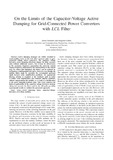Mostrar el registro sencillo del ítem
On the limits of the capacitor-voltage active damping for grid-connected power converters with LCL filter
| dc.creator | Samanes Pascual, Javier | es_ES |
| dc.creator | Gubía Villabona, Eugenio | es_ES |
| dc.date.accessioned | 2020-05-15T07:50:02Z | |
| dc.date.available | 2020-05-15T07:50:02Z | |
| dc.date.issued | 2018 | |
| dc.identifier.citation | J. Samanes and E. Gubia, 'On the Limits of the Capacitor-Voltage Active Damping for Grid-Connected Power Converters with LCL Filter,' 2018 IEEE 19th Workshop on Control and Modeling for Power Electronics (COMPEL), Padua, 2018, pp. 1-7, doi: 10.1109/COMPEL.2018.8460002. | en |
| dc.identifier.isbn | 978-1-5386-5541-2 | |
| dc.identifier.uri | https://hdl.handle.net/2454/36892 | |
| dc.description.abstract | Active damping strategies are widely extended to avoid stability issues at the LCL filter resonant poles in grid-connected voltage source converters. The capacitor voltage derivative active damping effectively damps the filter resonant poles without additional sensors, but it loses its effectiveness as the resonance frequency approaches the converter control Nyquist frequency, influenced by the existing delays in the control loop. To reduce this limitation, the delays can be reduced by performing a multisampled derivative, however, even though the stability limits might be extended, the oversampled approach might increase noise amplification problems. An appropriate filtering solution is required in the feedback path in order to reduce noise amplification and eliminate aliasing problems, without compromising the stability, as a result of a modification in the active damping feedback path. This work examines the limits of applicability of the capacitor voltage derivative strategy taking into account the filters used in the AD path, providing experimental results to validate the presented approach. | en |
| dc.description.sponsorship | This work has been supported by the Spanish State Research Agency (AEI) and FEDER-UE under grant DPI2016-80641-R, and partially funded by the Public University of Navarre through a doctoral scholarship. | en |
| dc.format.extent | 7 p. | |
| dc.format.mimetype | application/pdf | en |
| dc.language.iso | eng | en |
| dc.publisher | IEEE | en |
| dc.relation.ispartof | 2018 IEEE 19th Workshop on Control and Modeling for Power Electronics (COMPEL): Padova, Italy, June 25-28, 2018, pp. 1-7 | en |
| dc.rights | © 2018 IEEE. Personal use of this material is permitted. Permission from IEEE must be obtained for all other uses, in any current or future media, including reprinting/republishing this material for advertising or promotional purposes, creating new collective works, for resale or redistribution to servers or lists, or reuse of any copyrighted component of this work in other work | en |
| dc.subject | Active damping | en |
| dc.subject | Delay | en |
| dc.subject | Capacitor voltage derivative | en |
| dc.subject | LCL-filter | en |
| dc.subject | Stability | en |
| dc.title | On the limits of the capacitor-voltage active damping for grid-connected power converters with LCL filter | en |
| dc.type | info:eu-repo/semantics/conferenceObject | en |
| dc.type | Contribución a congreso / Biltzarrerako ekarpena | es |
| dc.contributor.department | Ingeniería Eléctrica, Electrónica y de Comunicación | es_ES |
| dc.contributor.department | Ingeniaritza Elektrikoa, Elektronikoa eta Telekomunikazio Ingeniaritza | eu |
| dc.contributor.department | Institute of Smart Cities - ISC | es_ES |
| dc.rights.accessRights | info:eu-repo/semantics/openAccess | en |
| dc.rights.accessRights | Acceso abierto / Sarbide irekia | es |
| dc.identifier.doi | 10.1109/COMPEL.2018.8460002 | |
| dc.relation.projectID | info:eu-repo/grantAgreement/ES/1PE/DPI2016-80641-R | en |
| dc.relation.publisherversion | https://doi.org/10.1109/COMPEL.2018.8460002 | |
| dc.type.version | info:eu-repo/semantics/acceptedVersion | en |
| dc.type.version | Versión aceptada / Onetsi den bertsioa | es |
| dc.contributor.funder | Universidad Pública de Navarra / Nafarroako Unibertsitate Publikoa | es |


